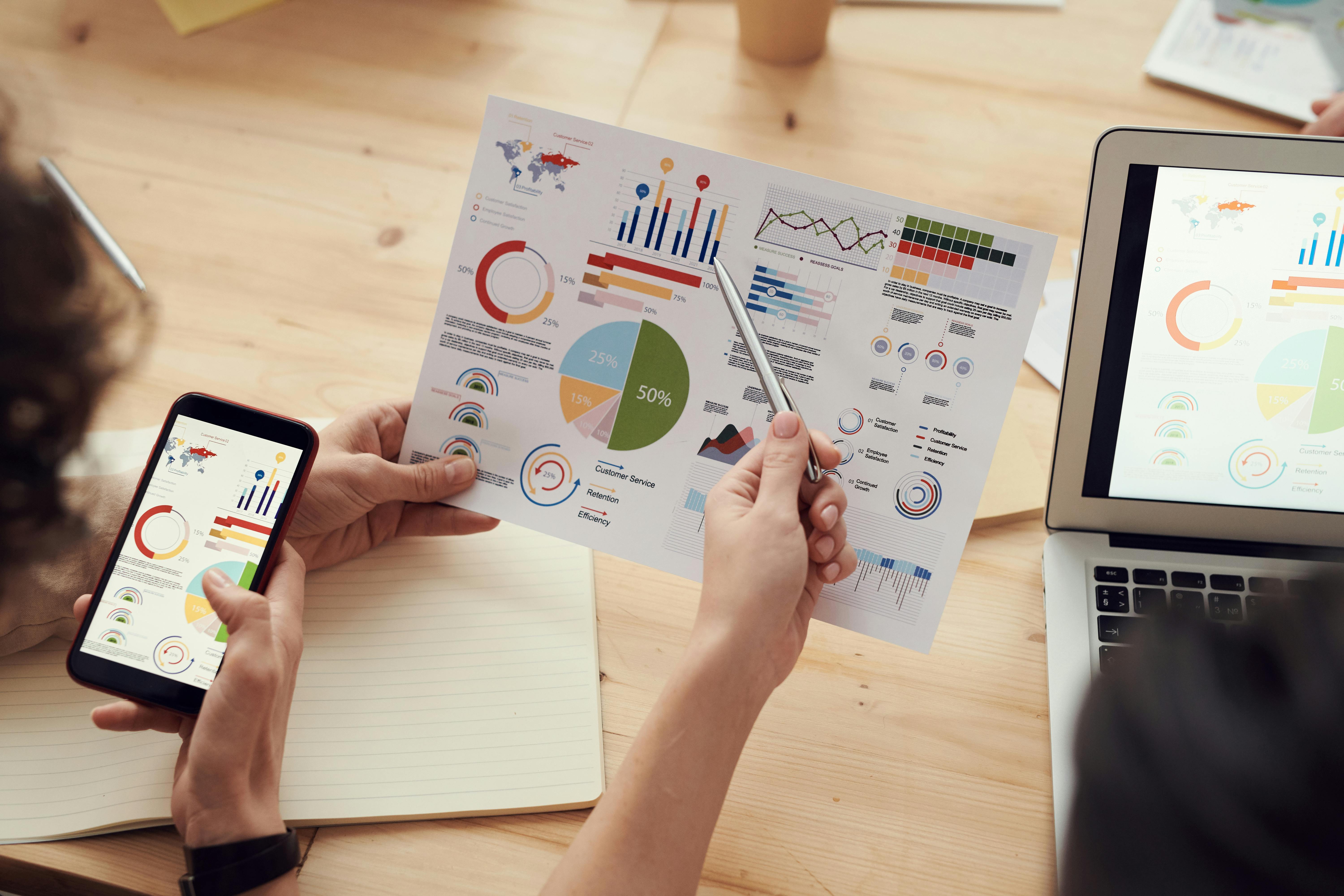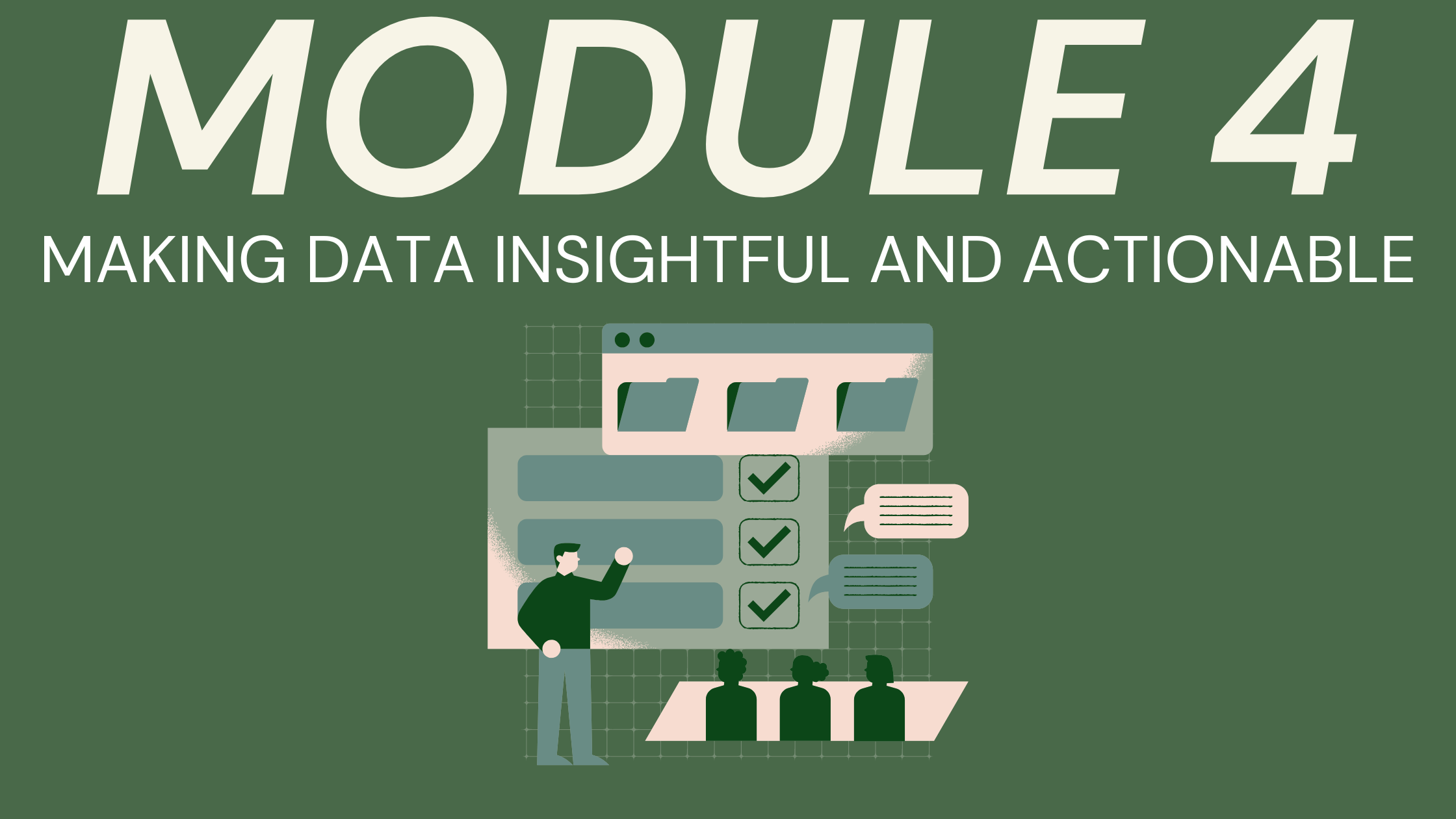Module 4: Making Data Insightful and Actionable
Learning Objectives
- Guide learners in interpreting data meaningfully within context.
- Demonstrate the best practices for communicating insights from data.
- Support others in making informed decisions based on data interpretation and synthesis.
Distilling the Basics of Data Analysis
Knowing about data and data sources is an important step towards data literacy. However, this knowledge is insufficient if not combined with knowledge of what you can do with said data. After all, the purpose of data science is not just to collect data for the sake of collecting, but rather to take the data and analyze it to generate new information about our world. All people should understand the basics of how we analyze data, create visualizations, and use our outcomes to tell stories and persuade others.

Regardless of how we analyze data - what specific transformations or tests we use - there are some common steps in the process of turning data into insights [1]. These steps include:
- Defining a question to address: Why do you want to analyze the data? What problem are you trying to solve or phenomena are you trying to understand? Defining a question is important to determining what types of data you need to collect and how you will analyze/synthesize it.
- Collecting and preparing the data: You have a question and now need to collect data to help answer it. But, as discussed in the prior module, there are several considerations to keep in mind: Is the data of high quality? Are there gaps in what we can answer with it? What are the limitations?
- Exploring the data: Once the data has been prepared for analysis, it is time to actually analyze it! Depending on the types of data (e.g., quantitative/qualitative, continuous/Likert/etc.), specific types of analysis will be used to generate insights. Again, one does not necessarily have to be an expert in all of these analytic methods to be “data literate.” However, they should have a functional understanding of how these methods work and what the outputs (things like means and frequency) mean.
- Drawing conclusions from the data: Now that the data has been analyzed, the findings need to be interpreted. What has been found and what is its significance? This often requires returning to the questions you originally wanted to address and seeing how the findings can help answer them.
- Sharing insights from the data: With the conclusions in hand, it is time to disseminate those findings to others. How can the insights gained be used in our lives? What are their significance? Being able to explain the meaning of statistics and figures, not just perform the analyses, is an important component of data literacy.
The Importance of Data Interpretation
Raw data cannot speak for itself. Often, the results that are produced following some kind of analysis are not in a format that can easily be consumed by others - numbers can easily be misunderstood or misused. It is the process of interpretation that transforms data into meaningful information that we can use. For this reason, some of the most important questions we can ask when assessing data literacy are “do you feel confident in understanding data visualizations” and “do you understand how to use data to inform decision making?” which get to the heart of being able to interpret findings [2].

Interpretation involves connecting the findings of analysis to its real-world implications. For instance, when we analyze the results of a survey looking at college students’ scores on a data literacy scale, we have a collection of results that tell us about student scores, but we make those results meaningful by explaining to others what they mean and contextualizing them within our existing knowledge about college students’ data literacy. Good interpretation will start by focusing on the subjects behind the data - What do these numbers mean? What do they actually represent?
When teaching data interpretation in higher education, one might begin by providing a series of problems that present statistics about various populations and then ask the learners to write a paragraph explaining what these statistics mean. They could then present these summaries to fellow learners to receive feedback and refine.
How Can We Communicate Data Effectively?
As noted above, the actual analysis of data is only one step in the process of turning data into insights. Perhaps the most critical stage in this process is being able to communicate the significance of the data to others and create meaning. One important strategy for this stage of the process is data storytelling, which combines your data-based findings with narrative elements and visualizations in order to make the message more memorable and persuasive. Data storytelling is key to ensuring the audience understands the significance of the findings and can apply it in their own lives [3].

Effective data storytelling requires awareness of the audience to which the data will be presented. Are they likely to be swayed by figures, or will a greater emphasis on the narrative elements be necessary? The communicator must design their presentation with proper language, level of complexity, and visual tools to match their audience. Care must also be placed in determining which visualizations will be most effective for the data and how the data is organized to avoid clutter and ensure visual consistency.
In teaching about data storytelling, it could be helpful to simply have learners practice creating stories around data for themselves [4]. One opportunity, discussed in our module, “Building a Data Culture on Your Campus” is to hold a data storytelling context, where students must locate a series of statistics and then create visualizations and a narrative to demonstrate the importance of these findings. The student(s) who perform the best could receive recognition or a prize to encourage a high level of competition.
Case Example
The Association for College and Research Libraries created a Learning Analytics Toolkit, which provides guidance on using library and educational data for generating insights to support your institution. Not only does this resource provide good information for performing analyses on your own data, it also gives a great example and framework for developing a similar tool for your institution. Presenting this data in an easily digestible format for students, faculty, and staff will help grow interest in using data analytics and stimulate exploration of data in general. Like with the ACRL’s example, it may be useful to engage in cross-campus or interdisciplinary collaboration on your resource guide and make sure there are ample linkages to other resources for those who are interested in exploring further!
Reflection Activity
In an digital document or notebook, answer the following questions about a dataset that you are familiar with (this could be a college-related dataset or something like polling data or health statistics):
- What question(s) is the data helping to answer?
- How could you communicate the key insights from this data to others?
- What decisions could you use this data to support?
Summary
Making data insightful and actionable requires more than technical analysis. It demands a thoughtful approach that includes understanding context, drawing meaningful interpretations, and communicating findings in ways that influence decisions. When educators and leaders combine rigorous analysis with storytelling, audience consideration, and ethical reflection, they unlock the power of data as a catalyst for informed action and positive change.
Additional Resources
References
- Oberascher, L., Ploder, C., Spiess, J., Bernsteiner, R., & Van Kooten, W. (2023). Data storytelling to communicate big data internally-a guide for practical usage. European Journal of Management Issues, 31(1), 27-39.
- Lund, B., Agbaji, D., & Teel, Z. A. (2023). Information literacy, data literacy, privacy literacy, and ChatGPT: Technology literacies align with perspectives on emerging technology adoption within communities. Human Technology, 19(2), 163-177.
- Lund, B. D. (2022). The Art of (Data) Storytelling. The International Journal of Information, Diversity, & Inclusion, 6(1/2), 31-41.
- McDowell, K., & Turk, M. J. (2024). Teaching data storytelling as data literacy. Information and Learning Sciences, 125(5/6), 321-345.
